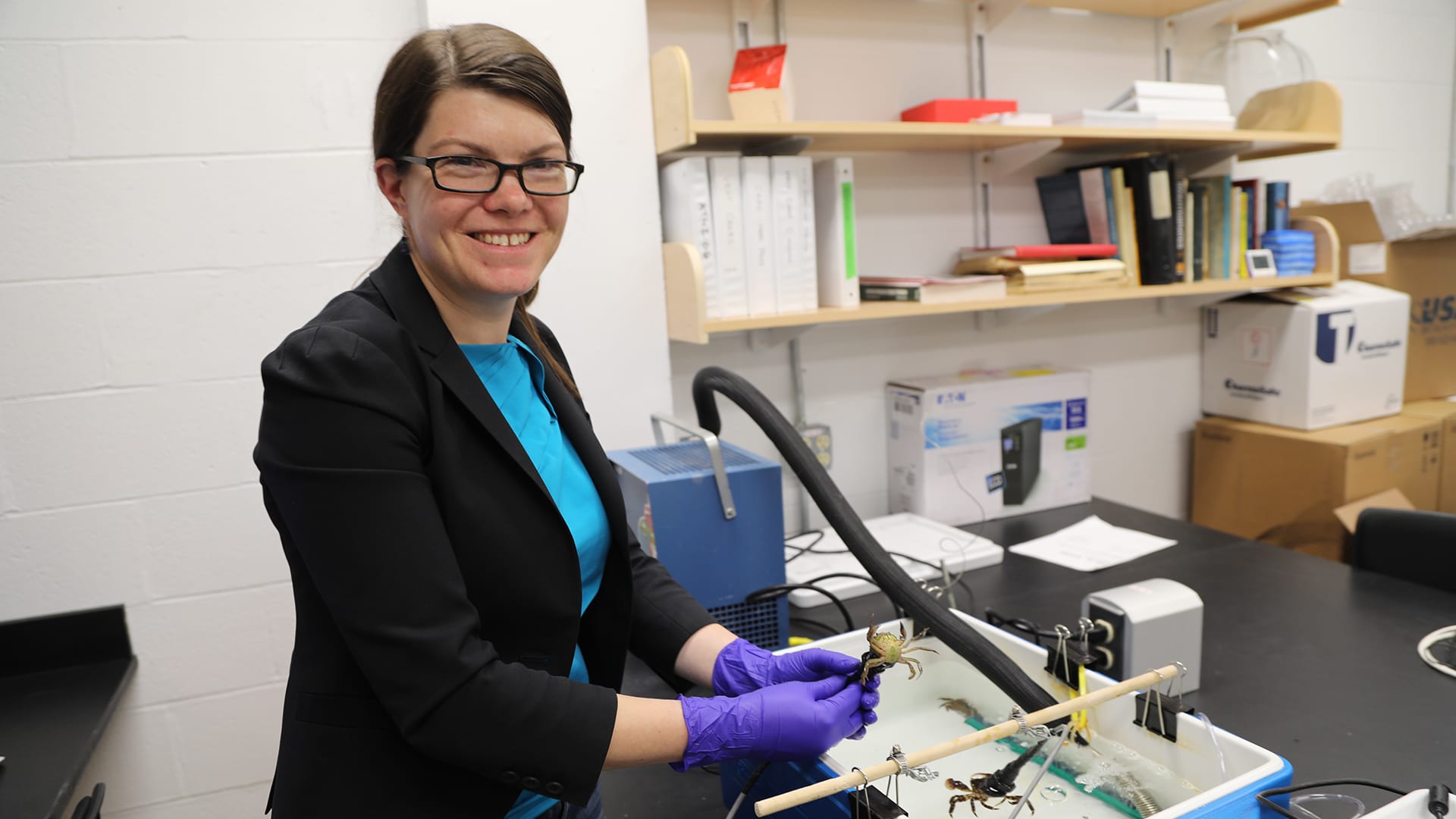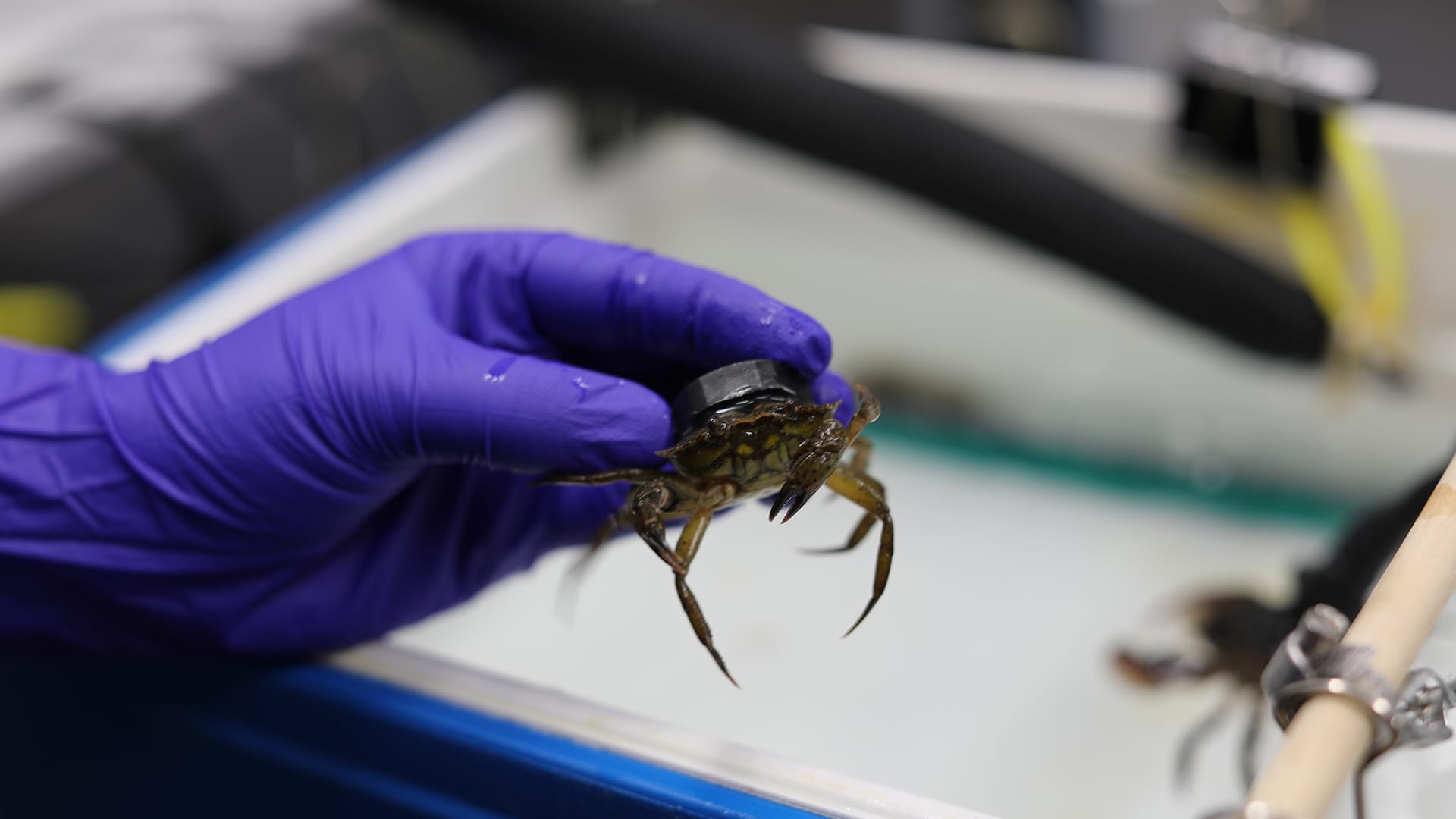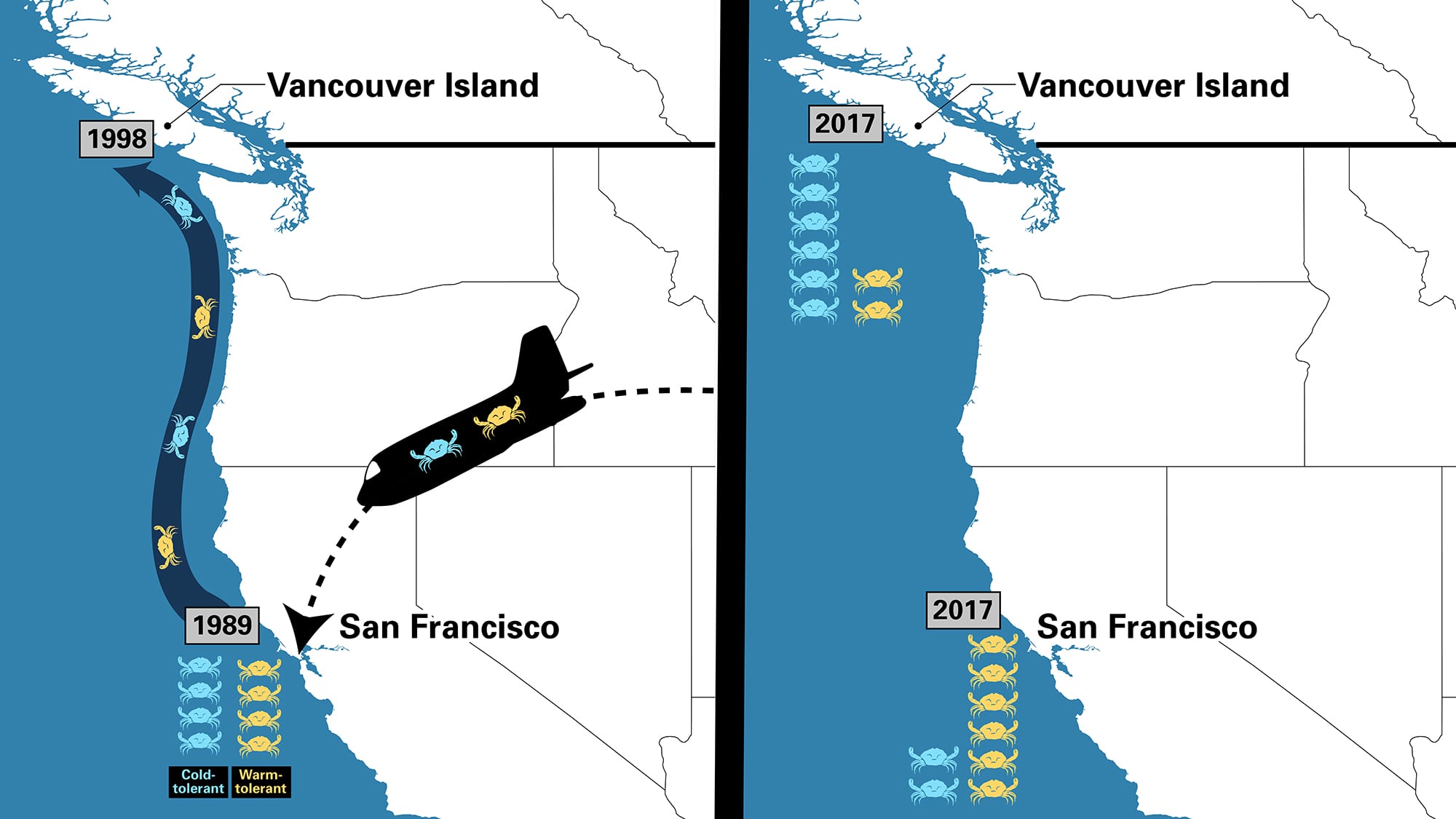Seeing Green (crabs)
Exploring adaptation in one of the world’s most resilient invasive species
Killer algae. Lionfish. Green crabs. Rock vomit. Dead Man’s Fingers.
Invasive species like these are unwanted and unwelcome—and nearly everywhere beneath the surface of the ocean. They coat boat hulls, foul propellers, and gobble up softshell clams and oysters before clammers and watermen have a chance to harvest them. They can be an ecological menace, an economic burden, and an aesthetic nightmare. (Waterfront view of rock vomit, anyone?)
Given this litany of disagreeableness, you might think that marine invasive species are incorrigible, irredeemable scoundrels. What to make of these clam-eating, fish-killing, boat-fouling uninvited guests?
Invasive species, above all, are survivors. They’re tough. To invade successfully, a species has to make it to a new shore. Once there, it has to survive. Gaining a toehold (though that’s probably not the right word for most marine species) is not enough. To be considered invasive, a species has to thrive and multiply and become so comfortable in its new home that it starts bothering the locals.
High-profile invasive species have beaten the odds again and again across the globe. In doing so, they have to deal with a wide range of novel conditions: new seas, new species, new temperatures. Invasive species are the ultimate embodiment of the old saying: “Bloom where you’re planted.”
Ironically, invasive species’ ability to adapt quickly to new environments also makes them ideal for investigating how native marine species may adapt to a changing world. As seas become warmer and more acidic, as ice shelves melt and sea level creeps up the shore, ocean creatures everywhere find their familiar homes shifting around them. What helps a survivor survive?
An empire of crabs
Let me tell you about one of these survivors, a personal favorite: the European green crab. Native from Norway to Morocco, green crabs have spread out, covering coastlines far beyond Europe. Like their human counterparts in the Age of Exploration, their colonial expansion is far-reaching: North America (both east and west coasts), Australia, Japan, South Africa, Argentina. But the sun hasn’t set on this empire of crabs, and unlike those of the Europeans of old, its boundaries are still expanding.
Really high-profile invasive species, such as green crabs, live across thousands of kilometers of ocean, spanning countless environmental differences, both small and large. If you’ve ever spent time on the coast of New England as a child, flipping rocks at the beach, you’ve certainly seen them.
They’ve been in the U.S. Northeast since the early 1800s, and they are not particularly gracious guests. They eat everything, and a lot of it. They spread out and get comfortable. And then they never leave.
Like all early American settlers, they first came on wooden sailing ships, hiding in holds in the nooks and algae-covered crannies between rocks once used as ballast against Atlantic storms. When we moved on to ships of steel with watertight tanks for water ballast, the crabs moved on too. When young, their larvae are part of the community of plankton that are sucked into holds in one port, moved across an ocean, and dumped out into a new port to make way for weighty cargo.
Now we can ship by air, sending live Maine lobster across the country overnight nestled in damp seaweed—and, likely, sending young crabs along for the ride, only to be discarded out the back doors of waterside seafood restaurants.
Master of all trades
Once transported, green crabs settle in, shaping their new lifestyles to the local conditions. It’s impossible to pin their success on a single, simple trait. Like any early colonist to a new shore, they are, above all, adaptable.
They eat what’s available, be it young shellfish or small soft-bodied creatures or even their own young. Despite their cannibalistic predilections, they live fairly cozily alongside one another, which under the right circumstances leads to huge populations.
They thrive in a wide range of temperatures, handle low salinity with aplomb, and are unusually resistant to environmental pollution. (Fascinatingly, they may also do well in their new homes because they tend to travel light, shedding much of the burden of their old-world parasites when they leave their native shores.)
As green crabs marched slowly up the coast of New England, softshell clam landings plummeted in their wake—first in Massachusetts, then decades later in Maine. (Mild winters in the early 20th century seemed to have contributed, with crab populations rising along with temperatures.)
In field experiments conducted in northern Maine in the 1950s, scientists put tiny seed clams in protective cages, and they survived and grew. But baby clams exposed to the crabs’ voracious appetites were dug up and eaten down to the last tiny shell. Today, they vex lobstermen, whose effort is wasted in pulling up trap after trap filled to the brim with green crabs.
But wait—can’t we just eat green crabs, solving a problem and opening up new culinary horizons in the process? I have eaten green crabs—served them at a biologists’ dinner party, in fact—and I can say this: I doubt it. There’s nothing wrong with the taste, which has the characteristic juicy sweetness of crustaceans. But the effort required to winkle tiny scraps of meat out of a thick and unyielding shell makes an afternoon picking Chesapeake blue crab look straightforward.
Over the years, there have been proposals to put this bounty of green crabs to use in other ways: ground into fertilizer, cut up for bait, even folded into empanadas. But so far, no industry has scaled to the point of making a dent in the green crab population. In one Newfoundland bay, where green crabs first extended their reach a decade ago, a few weeks of trapping by a few local fishers routinely yields green crab catches that can literally be measured in tons, requiring truck after truck to haul them all away. That’s a lot of empanadas.
Survive and thrive
Every invasion tells a story of survival. Some are fables of flexibility, where the moral is that it’s good to have options—to eat broadly and unpickily, to settle and grow on rocks and docks and pipes alike, to clone yourself without needing a partner, to be either the tortoise or the hare, or both, as circumstances dictate.
Others—my favorites—are sagas of evolution writ small, a generational journey from wide-eyed settler to raw-boned frontiersman. In every generation, the fittest survive, producing a population uniquely suited to its new home.
Green crabs’ broad adaptability may mask more subtle differences. Each new crab population harbors evolutionary potential—in the form of genes—passed down from its founders and shaped by its ancestral home. As successive generations of crabs pass through an environmental gauntlet, particular genetic markers may rise or fall in the population. By studying these fine-tuned invasive populations and seeing how they differ from one another and from their founding stock in the “old country,” we can follow the trail of adaptation almost in real time.
We used to think these evolutionary stories were rare in the ocean. That was when we saw the sea from above, as sailors and mapmakers do: a blue blankness stretching between continents, occasionally pricked with islands or whipped by wind, but with nothing of the cartographic complexity of land. After all, how much evolution is really necessary to thrive in one patch of blue versus another?
Now we know better. As we’ve developed subtler instruments and more rugged ships to map the mountains and canyons and shelves of the seabed, we have discovered undersea environments more varied and extreme than those on land. Improved sensors and analytical instruments have shown us that seafloor topography isn’t all that varies—each patch of ocean is shaped by an alchemical brew of chemistry, geology, temperature, and currents that makes it unique. Add in the fact that ocean creatures are living in a truly three-dimensional world, as opposed to the thin film of life clinging to the surface of the land, and you have a deep well of adaptive potential hiding just under the surface.
Work on the wild side
As our ability to see the ocean has improved, so has our ability to see subtle evolutionary changes. Evolution, at its most basic, is stamped into each creature’s DNA. Detecting this process of genetic change over tiny time scales is a fairly new art, made possible by spectacular shifts in technology—decoding genomes, simultaneously reading millions and then billions of base pairs of DNA, and cluster-computing to make sense of wells of data far deeper than any person could plumb unassisted. Molecular ecologists like me ride the wake of these discoveries, taking what was pioneered in mice and fruit flies and using it to examine life in the ocean.
Much of my research is interested in comparing the same species across different environments, to see how—and how fast—animals can adapt to the local conditions. It can be particularly interesting to run these comparisons both at home and abroad. While in grad school, I tested crabs in their native range, contrasting those from sun-soaked Portugal to their Scandinavian counterparts in Norway. They’re the same species, but like people, they differ depending on their roots.
Northern crabs do better in the cold than southern crabs, maintaining higher heart rates even at 0°C when ice starts to form in their experimental tanks. At the opposite end of the thermometer, Portuguese crabs can better survive hotter exposures than Norwegians can, by a difference of several degrees. These differences likely have deep evolutionary roots, shaped by millennia of life along a wide latitudinal swathe. More interesting, then, is to follow the crabs abroad and see how they change after only decades to centuries in new waters.
On the west coast of North America, green crabs were first discovered in 1989 in San Francisco Bay. Hippies and techies aren’t the only ones drawn to the area—the bay itself is a world-leading hot spot of marine invasions, with hundreds of introduced species. (I believe rent is cheaper for the crabs than for the human residents, however.)
Like any good Bay Area entrepreneur, green crabs lost no time in spreading their influence. In under 10 years, they expanded into bays and estuaries from central California to British Columbia. Since then, populations have waxed and waned along with ocean conditions, but they have never gone away. Genetic work has told us that all of these populations are descended from the original San Franciscan settlers, so they started out with the same basic genetic makeup. This common background means that any differences between populations must have arisen post-1989.
The sleek new tools borrowed from medical researchers have enabled me to scan the DNA of dozens of crabs across these populations, picking out genes that vary along with temperatures. I’m currently in the midst of this work, disentangling the fingerprints of selection from the many random factors that also leave a mark on the genome. I’m looking for genes that vary predictably from population to population, depending on the temperatures where they live. These genes, in turn, will be compared with those that I found earlier while rummaging around in the genomes of crabs in Europe and on the East Coast of North America.
If the same genes show the same predictable patterns with temperature in place after place, that’s good evidence that they may contribute to the spread and persistence of this highly spreading, very persistent species. Looking a little further along, I’m working on designing new experiments to test these genes more explicitly, to see how they might control a crab’s response to temperature.
This is the process of working in wild systems. Find genetic differences between populations. Find functional differences between populations. Tie them together to establish that this gene variant impacts that trait under these conditions. Strictly controlled laboratory experiments are invaluable for telling us how evolution can proceed. But out in the wild, untidy complexity of the sea, we can discover how it does proceed.
The return of the natives
We’ve known the broad strokes of adaptive evolution for centuries—since Gregor Mendel and his monastery pea plants, since Darwin and Wallace and their exotic island birds. But as we turn high-tech tools toward nature, we see example after example of small-scale adaptation. Species can carry within themselves the potential to change in response to a changing sea.
The surprise, and the promise, is in the speed at which these changes can happen. For invasion biology, this would not be welcome news. The empires of crabs, and rock vomit, lionfish, and all their brethren may adapt as they expand. That is, on its face, a fairly grim prospect.
However, these adaptable invaders may also shine a light on the future of their homebody counterparts. Invasive species provide a natural laboratory to explore adaptation to a changing world.
If evolution in the ocean can proceed much more swiftly than we had assumed in the days of blue and featureless seas, perhaps there’s some hope that native creatures will also be able to change to survive. By understanding the expansion of invaders, perhaps we can help protect the future prospects of species on their native shores. After all, even invasive species are native to somewhere.
The research described here spans multiple projects, which have variously been funded by the National Science Foundation, the James S. Cole and Cecily C. Selby Endowed Fund in Support of Scientific Staff, a National Defense Science and Engineering Graduate Fellowship, a Stanford Center for Computational, Evolutionary, and Human Genomics Fellowship, and a Smithsonian Biodiversity Genomics Postdoctoral Fellowship.



